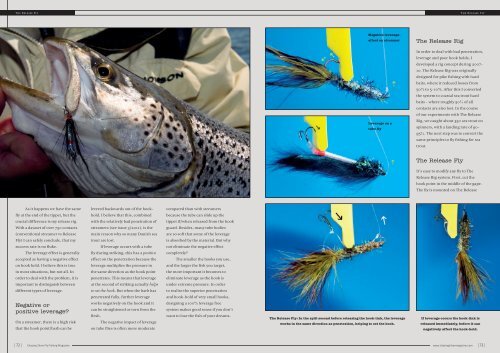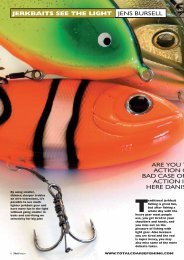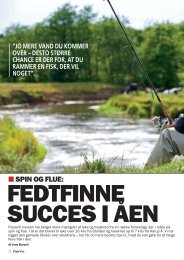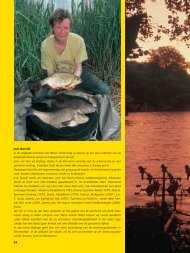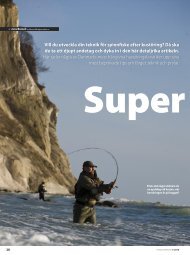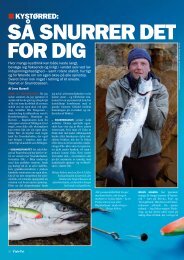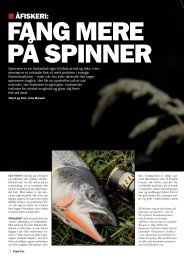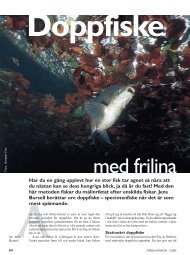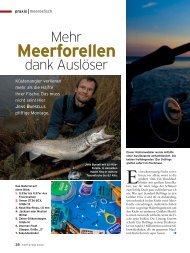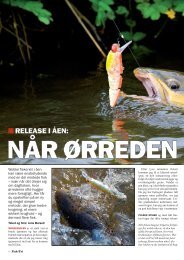Read article (pdf - 2480 KB) - Jens Bursell
Read article (pdf - 2480 KB) - Jens Bursell
Read article (pdf - 2480 KB) - Jens Bursell
- No tags were found...
You also want an ePaper? Increase the reach of your titles
YUMPU automatically turns print PDFs into web optimized ePapers that Google loves.
The Release Fly<br />
The Release Fly<br />
Negative leverageeffect<br />
on streamer<br />
Leverage on a<br />
tube fly<br />
The Release Rig<br />
In order to deal with bad penetration,<br />
leverage and poor hook holds, I<br />
developed a rig concept during 2007-<br />
10. The Release Rig was originally<br />
designed for pike fishing with hard<br />
baits, where it reduced losses from<br />
50% to 5-10%. After this I converted<br />
the system to coastal sea trout hard<br />
baits - where roughly 50% of all<br />
contacts are also lost. In the course<br />
of our experiments with The Release<br />
Rig, we caught about 350 sea trout on<br />
spinners, with a landing rate of 90-<br />
95%. The next step was to convert the<br />
same principles to fly fishing for sea<br />
trout.<br />
The Release Fly<br />
It’s easy to modify any fly to The<br />
Release Rig system. First, cut the<br />
hook point in the middle of the gape.<br />
The fly is mounted on The Release<br />
As it happens we have the same<br />
levered backwards out of the hook-<br />
compared than with streamers<br />
fly at the end of the tippet, but the<br />
hold. I believe that this, combined<br />
because the tube can slide up the<br />
crucial difference is my release rig.<br />
with the relatively bad penetration of<br />
tippet if/when released from the hook<br />
With a dataset of over 750 contacts<br />
streamers (see issue 3/2011), is the<br />
guard. Besides, many tube bodies<br />
(conventional streamer vs Release<br />
main reason why so many Danish sea<br />
are so soft that some of the leverage<br />
Fly) I can safely conclude, that my<br />
trout are lost.<br />
is absorbed by the material. But why<br />
success rate is no fluke.<br />
If leverage occurs with a tube<br />
not eliminate the negative effect<br />
The leverage effect is generally<br />
fly during striking, this has a positive<br />
completely<br />
accepted as having a negative effect<br />
effect on the penetration because the<br />
The smaller the hooks you use,<br />
on hook hold. I believe this is true<br />
leverage multiplies the pressure in<br />
and the larger the fish you target,<br />
in most situations, but not all. In<br />
the same direction as the hook point<br />
the more important it becomes to<br />
order to deal with the problem, it is<br />
penetrates. This means that leverage<br />
eliminate leverage as the hook is<br />
important to distinguish between<br />
at the second of striking actually helps<br />
under extreme pressure. In order<br />
different types of leverage.<br />
to set the hook. But when the barb has<br />
to realise the superior penetration<br />
penetrated fully, further leverage<br />
and hook-hold of very small hooks,<br />
Negative or<br />
positive leverage<br />
On a streamer, there is a high risk<br />
that the hook point/barb can be<br />
works negatively on the hook and it<br />
can be straightened or torn from the<br />
flesh.<br />
The negative impact of leverage<br />
on tube flies is often more moderate<br />
designing a 100% leverage free<br />
system makes good sense if you don’t<br />
want to lose the fish of your dreams.<br />
The Release Fly: In the split second before releasing the hook-link, the leverage<br />
works in the same direction as penetration, helping to set the hook.<br />
If leverage occurs the hook-link is<br />
released immediately, before it can<br />
negatively affect the hook-hold.<br />
| 72 |<br />
Chasing Silver Fly Fishing Magazine www.chasingsilvermagazine.com | 73 |


